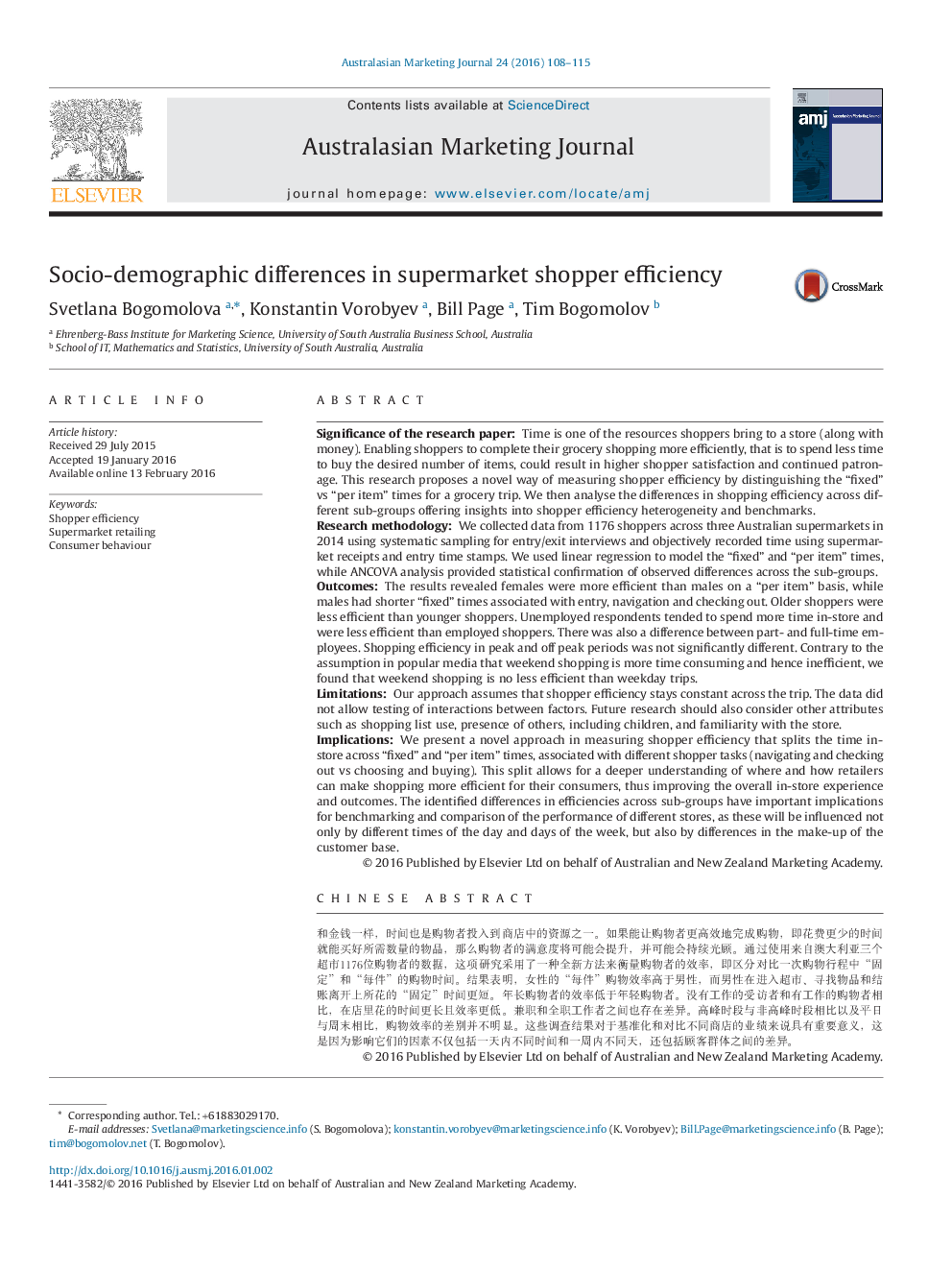| کد مقاله | کد نشریه | سال انتشار | مقاله انگلیسی | نسخه تمام متن |
|---|---|---|---|---|
| 1026852 | 1377809 | 2016 | 8 صفحه PDF | دانلود رایگان |
• We measure shopping efficiency as “fixed” and “per item” time, analysing data from 3 Australian supermarkets.
• Females are more efficient per item, while males spend less time on fixed shopping (getting in and out of the store).
• Older and unemployed shoppers are less efficient shoppers than younger and employed.
• Little difference between peak/off peak and weekday/weekend shopping.
• Dividing the trip into fixed and per-item efficiency allows more accurate comparison between stores and categories.
Significance of the research paperTime is one of the resources shoppers bring to a store (along with money). Enabling shoppers to complete their grocery shopping more efficiently, that is to spend less time to buy the desired number of items, could result in higher shopper satisfaction and continued patronage. This research proposes a novel way of measuring shopper efficiency by distinguishing the “fixed” vs “per item” times for a grocery trip. We then analyse the differences in shopping efficiency across different sub-groups offering insights into shopper efficiency heterogeneity and benchmarks.Research methodologyWe collected data from 1176 shoppers across three Australian supermarkets in 2014 using systematic sampling for entry/exit interviews and objectively recorded time using supermarket receipts and entry time stamps. We used linear regression to model the “fixed” and “per item” times, while ANCOVA analysis provided statistical confirmation of observed differences across the sub-groups.OutcomesThe results revealed females were more efficient than males on a “per item” basis, while males had shorter “fixed” times associated with entry, navigation and checking out. Older shoppers were less efficient than younger shoppers. Unemployed respondents tended to spend more time in-store and were less efficient than employed shoppers. There was also a difference between part- and full-time employees. Shopping efficiency in peak and off peak periods was not significantly different. Contrary to the assumption in popular media that weekend shopping is more time consuming and hence inefficient, we found that weekend shopping is no less efficient than weekday trips.LimitationsOur approach assumes that shopper efficiency stays constant across the trip. The data did not allow testing of interactions between factors. Future research should also consider other attributes such as shopping list use, presence of others, including children, and familiarity with the store.ImplicationsWe present a novel approach in measuring shopper efficiency that splits the time in-store across “fixed” and “per item” times, associated with different shopper tasks (navigating and checking out vs choosing and buying). This split allows for a deeper understanding of where and how retailers can make shopping more efficient for their consumers, thus improving the overall in-store experience and outcomes. The identified differences in efficiencies across sub-groups have important implications for benchmarking and comparison of the performance of different stores, as these will be influenced not only by different times of the day and days of the week, but also by differences in the make-up of the customer base.
Chinese abstract和金钱一样,时间也是购物者投入到商店中的资源之一。如果能让购物者更高效地完成购物,即花费更少的时间就能买好所需数量的物品,那么购物者的满意度将可能会提升,并可能会持续光顾。通过使用来自澳大利亚三个超市1176位购物者的数据,这项研究采用了一种全新方法来衡量购物者的效率,即区分对比一次购物行程中“固定”和“每件”的购物时间。结果表明,女性的“每件”购物效率高于男性,而男性在进入超市、寻找物品和结账离开上所花的“固定”时间更短。年长购物者的效率低于年轻购物者。没有工作的受访者和有工作的购物者相比,在店里花的时间更长且效率更低。兼职和全职工作者之间也存在差异。高峰时段与非高峰时段相比以及平日与周末相比,购物效率的差别并不明显。这些调查结果对于基准化和对比不同商店的业绩来说具有重要意义,这是因为影响它们的因素不仅包括一天内不同时间和一周内不同天,还包括顾客群体之间的差异。
Journal: Australasian Marketing Journal (AMJ) - Volume 24, Issue 2, May 2016, Pages 108–115
